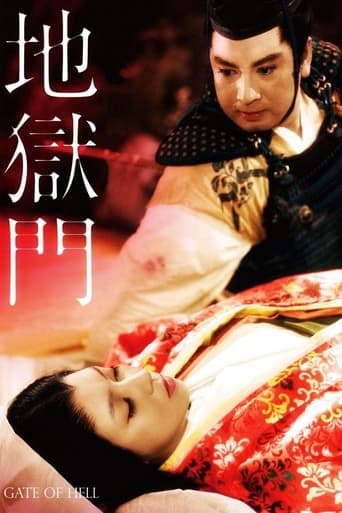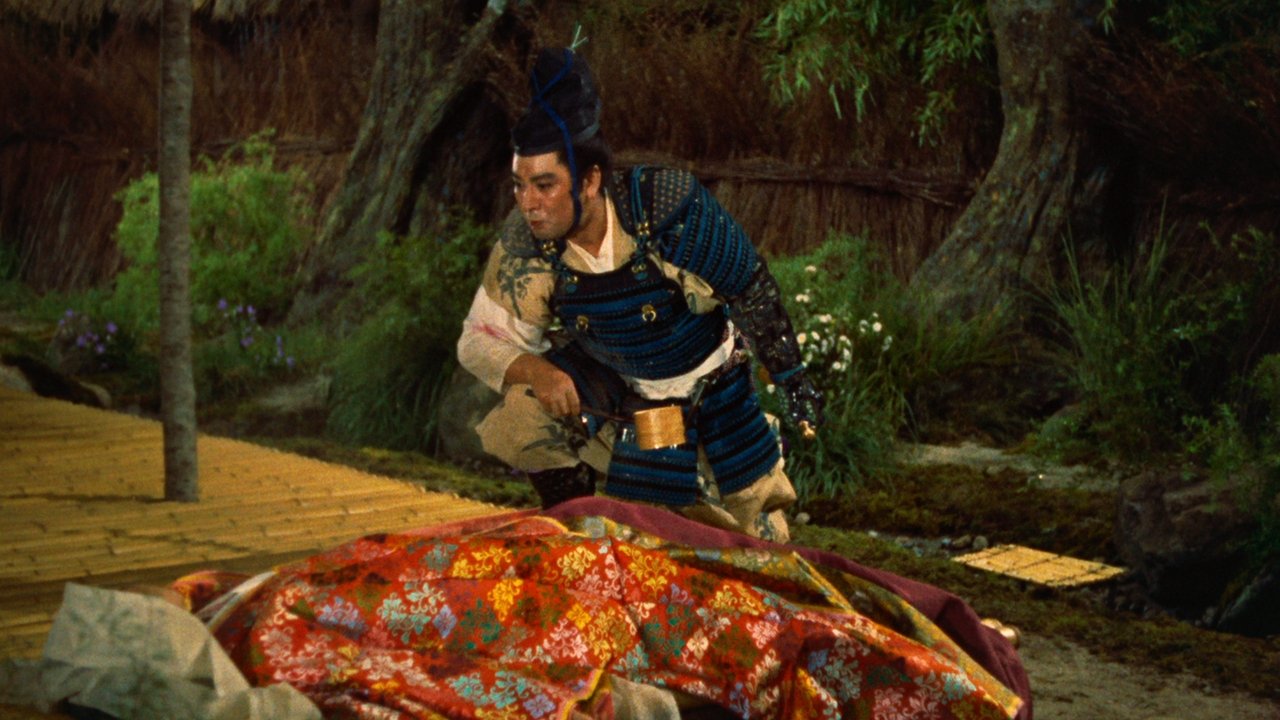WILLIAM FLANIGAN
Viewed on DVD. Restoration = ten (10) stars; color photography = nine (9) stars; costumes and set designs = nine (9) stars; subtitles = three (3) stars; choreography/stunts = two (2) stars. Director Teinosuke Kinugasa's tale takes place when the age of the Samurai soldier class was just beginning (late 1100's). His film begins with rousing scenes (and a matching orchestral score!) that have the look (photographed in gorgeous color) and feel (great editing) of an epic film. Unfortunately, the excitement is fleeting (it lasts for just about one reel--less than 10 minutes): the photo play rapidly dissolves into stagy, melodramatic nonsense. The score is also down sized from an orchestra to a single Shamisen or Koto. Red-flag warnings that the best has come and is going/gone include: frequent voice-over expository (NEVER a good sign); limply choreographed sword fights (stunt extras make a big show of sword pointing, but rarely are shown to follow through); and a ridiculous chase scene (stunt performers are "shot off " their horses with arrows that only appear after the fact (when a "dead" rider is shown crumpled on the ground)). The performance of the lead actor (who has a pathological sex-object fixation) is pretty much limited to fuming facial expressions. While the lead actress (the sex object) pretty much plays a "dumb brunette." Neither appears to have received much guidance from the Director. Interior sets, costumes, and makeup add much to project an aura of period authenticity. Costuming includes the use of colored horse blankets to help the audience separate the good guys who used to be the bad guys from the bad guys posing as good guy who use to be the really bad guys (or was it the other way around?). All of whom, of course, are played by the same stunt actors. The scenario delivers a surprise ending which is tragic but nonetheless pretty dumb. Cinematography (narrow screen, color) and interior lighting are excellent. Subtitles are in great need of adult grammatical editing. They are usually too long, too complicated/abstract, and too short in their screen flash rates. (Constantly having to press the pause button on your player to read/check translations is a royal pain!) Great in several (mostly technical) respects, but not a great movie overall. WILLIAM FLANIGAN, PhD.
screaminmimi
Great find at my public library: eye-poppingly gorgeous restored print of Kinogasa Teinosuke's 1953 "Gate of Hell (Jigoku Mon)" out in Criterion edition, UPC: 7-15515- 10451-7Has everything visually that drew me to classic Japanese cinema when I was a kid. The color and pattern sense of 12th century clothing and home décor and the use of light and shadow one was more likely to see in a b&w film than in most Technicolor films of the early 1950's.The story is based on a contemporary historical account of the Heiji Rebellion of 1160 and its aftermath, intertwining images from a picture scroll depicting the rebellion with the live action of the movie. The plot centers on the lives of three people caught up in what would have been a love triangle if the lady in question had agreed to it. Instead, she is the victim of Travis Bickel-like stalker who won't take "no" for an answer. May not be for all tastes: not as much chambara (sword fighting) as some people like in their jidaigeki (historical dramas), and a little over the top on the melodrama, but still worth seeing, especially from the technical standpoint of benchmarking a great job of color film restoration. Not garish, but jaw-droppingly accurate.
Robert J. Maxwell
A Shakespearean story of passion and honor. Watanabe and Kesa are a happily married couple of the ruling class in 1330s Japan. He's a peaceful, kind, good-natured gentleman. She's quiet, obedient, and plays the koto with delicacy -- my kind of woman. But then there's the warrior Morito. He's headstrong and bullying. He develops a passion for Kesa. He constantly natters Watanabe, trying to chivvy him into a sword fight but Watanabe is too dignified and equally self confident. The public favors Watanabe and when he loses a horse race to the grimly determined Morito, his friends try to make excuses for him. "You refused to whip your horse, didn't you?" But it's infra dig. "No, he was the more skilled rider." Morito forces Kesa into a plot to kill Watanabe, so they can be together, but she loves her husband. I don't think I'll get into the plot any further.The thing is a visual pageant. You've rarely seen colors come alive in quite this way. Not lurid, like a slasher movie, but very carefully matched against one another. A crimson banner rises into a crisp blue sky. Damme, the Japanese and the Chinese have a taste for things like colors and composition.Morito's bull headedness come across as overdone. It's a weakness in these kinds of films. The bad guy tends to shout and rave loudly. Not always. The sword fights are graceless, quick, and bloodless. Kurasawa handled them with more style.It may be a little test of endurance to get into it at first. The opening has a narration explaining some of Japanese history that turns out to be of little relevance to the main plot. The story has nothing to do with politics. It pits reason and common sense against misplaced emotion. Try it for half an hour, then decide.
dwjjunk
Being a fan of the "Samurai" genre, I was taken in by this film. I actually found this video at the local library. The visuals are wonderful, sword-play is very realistic, acting is excellent. The plot comes on strong, but becomes very predictable by the end. Still, worth checking out.


 AD
AD



